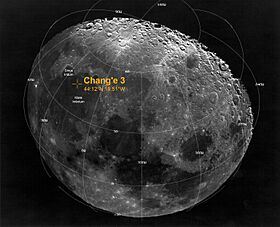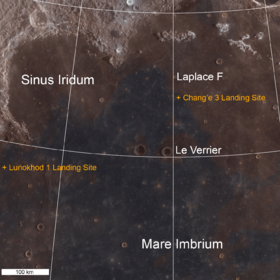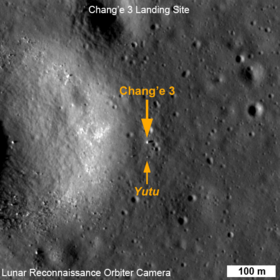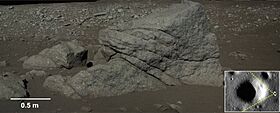Yutu (rover) facts for kids
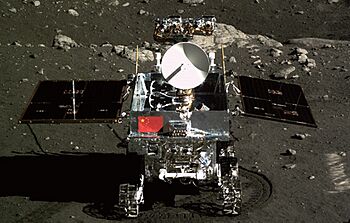
Yutu rover on lunar surface
|
|
| Mission type | Lunar rover |
|---|---|
| Operator | CNSA osrg |
| Mission duration | 3 months (planned) Actual: 973 days Immobile since 25 January 2014, 42 days after landing. |
| Spacecraft properties | |
| Manufacturer | SASEI and BISSE |
| Landing mass | 140 kg (310 lb) |
| Dimensions | 1.5 m (4.9 ft) |
| Power | • Solar panels for electricity • Radioisotope heater units for heating |
| Start of mission | |
| Launch date | 1 December 2013, 17:30 UTC |
| Rocket | Long March 3B Y-23 |
| Launch site | Xichang LC-2 |
| Deployed from | Chang'e 3 |
| End of mission | |
| Declared | 3 August 2016 |
| Last contact | Mid-2016 |
| Lunar rover | |
| Landing date | 14 December 2013, 13:12 UTC |
| Landing site | Mare Imbrium 44°07′N 19°31′W / 44.12°N 19.51°W |
| Distance covered | 114.8 m (377 ft) |
|
Chinese Lunar Exploration Program rovers
|
|
The Yutu (pronounced Yoo-too) rover was a special robot from China that explored the Moon. Its name means 'Jade Rabbit' in Chinese, named after a rabbit in Chinese stories about the Moon. Yutu was part of the Chang'e 3 mission.
It launched on December 1, 2013, and landed on the Moon on December 14, 2013. This was the first time a spacecraft had soft-landed on the Moon since 1976. It was also the first rover to work there since the Soviet Lunokhod 2 in 1973.
Yutu faced some problems after its second lunar day. It could not move anymore, but it kept sending back useful information for many months. In October 2015, Yutu became the rover that had worked the longest on the Moon.
It finally stopped working on July 31, 2016. This was 31 months after it landed, much longer than its planned three-month mission. While on the Moon, Yutu traveled 114 meters (about 374 feet).
A new rover, called Yutu-2, was launched in 2018 as part of the Chang'e 4 mission.
Contents
Building the Yutu Rover
The Yutu lunar rover was built by two Chinese groups: Shanghai Aerospace System Engineering Institute (SASEI) and Beijing Institute of Spacecraft System Engineering (BISSE). Work on the six-wheeled rover started in 2002 and finished in May 2010.
The rover was designed to drive off its lander and explore the Moon's surface by itself. Its name, Yutu, was chosen by people in an online poll. It refers to the Moon rabbit, a pet of Chang'e, the Moon goddess in Chinese mythology.
What Yutu Was Meant to Do
The main goal of the Chang'e-3 mission was for China to successfully land a spacecraft and a rover on the Moon for the first time. It also aimed to test new technologies for future space missions.
The scientific goals included studying the Moon's surface and its geology. Yutu also looked at what the Moon's surface is made of and searched for resources. It also studied the space environment between the Sun, Earth, and Moon.
The Chang'e 3 mission was the first to use radar to measure the depth of the lunar soil. It could see down to 30 meters (about 98 feet) deep. It also looked at the Moon's crust hundreds of meters deep.
The Chinese Lunar Exploration Program has three main parts:
- Orbiting: Sending spacecraft to fly around the Moon (like Chang'e 1 and Chang'e 2).
- Landing: Landing spacecraft on the Moon (like Chang'e 3 and Chang'e 4).
- Sample return: Bringing Moon rocks back to Earth (like Chang'e 5).
Yutu's Design and Tools
The China National Space Administration (CNSA) does not share much information about its missions. So, we don't have all the details about Chang'e 3.
Yutu weighed 140 kilograms (about 309 pounds) and could carry 20 kilograms (about 44 pounds) of tools. It was smaller than NASA's Mars rovers, Spirit and Opportunity.
Yutu had tools like panoramic cameras, an infrared spectrometer, and an alpha particle X-ray spectrometer (APXS). It also had a robotic arm to place its APXS tool close to samples. The rover could send live video and had sensors to avoid bumping into things.
Yutu was designed to explore an area of 3 square kilometers (about 1.2 square miles). It could travel up to 10 kilometers (about 6.2 miles). It got its power from two solar panels during the lunar day.
During the 14-day lunar nights, Yutu went into a sleep mode. It used special heaters called radioisotope heater units (RHU) to stay warm.
Yutu's Scientific Tools
The Yutu rover carried a ground-penetrating radar and spectrometers. These tools helped it study the soil and the Moon's crust beneath the surface.
Ground-Penetrating Radar (GPR)
The GPR was on the underside of the rover. It was the first time this type of radar was used to directly measure the Moon's soil. It could see down to 30 meters (about 98 feet) deep. It also helped study the Moon's crust hundreds of meters deep.
Spectrometers
Yutu had an alpha particle X-ray spectrometer (APXS) and an infrared spectrometer. These tools were used to figure out what chemical elements were in the Moon's samples. The APXS was on the robotic arm.
Stereo Cameras
The rover had two panoramic cameras and two navigation cameras on its mast. This mast stood about 1.5 meters (about 5 feet) above the Moon's surface. It also had two cameras at the front to avoid hazards. Each pair of cameras could take 3D pictures or measure distances.
Where Yutu Landed
The Chang'e 3 spacecraft landed on December 14, 2013. The Yutu rover drove off the lander about 7 hours and 24 minutes later.
The original plan was to land in a place called Sinus Iridum. But the lander actually touched down in Mare Imbrium. This spot was about 40 kilometers (about 25 miles) south of a crater named Laplace F.
How Yutu Operated
First Lunar Day
The rover successfully drove onto the Moon's surface on December 14, 2013. By December 17, most of its scientific tools were working well. Both the lander and rover were doing great, even with the Moon's tough conditions.
From December 16 to December 20, 2013, the rover stayed still. Its systems were partly turned off because the Sun made one side of the rover very hot (over 100°C), while the shaded side became very cold (below 0°C).
By December 22, Yutu had finished its first main task. It took pictures of the lander from different angles. The lander also took photos and videos of the rover moving. Many of these images were shared, including 3D views.
Yutu also checked its systems on December 23 to get ready for the long lunar night. It moved about 40 meters (about 131 feet) south of the lander. Both the lander and rover went into a low-power "sleep mode" to save energy. They had to survive the extremely cold two-week-long lunar nights.
Second Lunar Day
On January 11, 2014, after the lunar night, the rover woke up. It completed its first lunar soil inspection on January 16, 2014.
On January 25, 2014, near the end of the second lunar day, China announced a problem. The rover had a "mechanical control abnormality" because of the "complicated lunar surface environment." This meant the rover was not responding to commands correctly. It could not get ready for the coming night properly. It turned out that a part of its driving system broke. This stopped it from folding its mast and solar panels for protection.
Third Lunar Day
On February 12, 2014, mission control tried to talk to Yutu after its second lunar night. They thought it was broken forever. But on February 13, it surprisingly started communicating again! China's lunar program spokesman said Yutu could talk, but it still had a "mechanical control abnormality," meaning it could not move.
The rover went into its third sleep period on February 22, 2014. It stayed still, and the serious technical problems continued. Scientists found that a control circuit had failed. This stopped Yutu from going into normal sleep mode. However, its radar, panoramic, and infrared cameras were still working.
Later Operations and End of Mission
Even though Yutu was stuck, it kept working much longer than expected. Its solar panels could not move to protect its inside parts from the cold. This exposed its electronics to the Moon's harsh environment.
Over time, Yutu lost some abilities. But it kept sending data every lunar day. Mission control wanted to keep Yutu working as long as possible. This would give them valuable information about how its parts lasted in the lunar environment.
By the end of October 2015, Yutu had set a record for the longest time a rover had operated on the Moon. Even though it was mostly stuck in one place.
On August 3, 2016, it was reported that the rover had stopped communicating. This meant the mission had officially ended.
Discoveries Made by Yutu
The rover's ground-penetrating radar found at least nine different rock layers. This showed that the area had surprisingly complex geological processes. It was also different from the landing sites of the Apollo and Luna missions.
On April 15, 2014, the Chang'e 3 mission, including Yutu, saw a total eclipse of the Sun by the Earth from the Moon's surface.
See also
 In Spanish: Yutu para niños
In Spanish: Yutu para niños
- Chinese Lunar Exploration Program
- Yutu-2 rover
- List of artificial objects on the Moon
- List of missions to the Moon
- Lunar rover
- Rover (space exploration)



